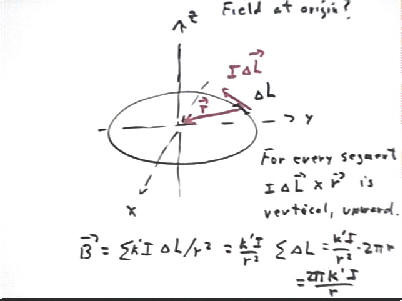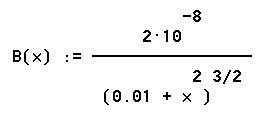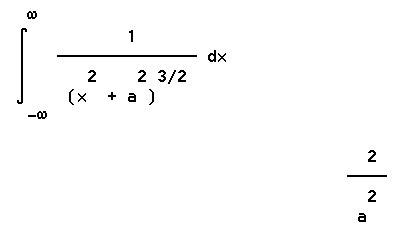The following are basic principles of magnetism:
The total magnetic flux through any closed surface is zero (Gauss' Law for magnetism).
The magnetic field from a current segment I `dL is
B = k ' * I `dL / r^2 * sin(theta).
This is the Law of Biot-Savart
A current segment I `dL experiences force
F = I `dL B sin(theta).
If a charge q moves at velocity v thru a magnetic field B, then the force experienced by the charge is
F = q v B sin(theta)
Directions in every case are determined by the right-hand rule.
Another law is Ampere's Law, which only University Physics students need to understand. It says rougly that the line integral of the magnetic field around any closed loop is equal to the total current which penetrates the interior of that loop.
Sketch the electric field lines that result from a single positive and a single negative charge, separated by some distance, with the charges equal and opposite.
The figure below depicts the field lines. These field lies are at every point tangent to the electric field vector. These lines were depicted in earlier classes and we are reminded of them here because we are going to apply this idea to magnetic fields.
A magnet is in the form of a rectangular solid with its north pole on one of the two largest faces of the solid, the south pole on the other of these two faces. Sketch the field lines of this field.
The two faces act in a manner analogous to two flat charged surfaces. Except near the edges the field comes out of one pole perpendicular to that pole, then at larger distances is gradually 'bent' in the direction of the opposite pole until it 'circles around' to that pole (the field lines do not really form circles).
Now imagine that we place the magnet in a rectangular box, with the center of the magnet at the center of the box. Sketch a side view of this configuration and sketch the magnetic field as it passes through the top, sides and bottom of the box.
The box with the magnet and its field lines is depicted below. The magnetic field is strongest directly above and below the center of the box. The red arrow indicate the field. Note the symmetry of the figure.
As we can see magnetic flux is entering the box at some points (all along the bottom and along the lower halves of the sides) and exiting at others (the top and the top halves of the sides). Is the net magnetic flux into the box positive, negative or zero?
By the symmetry of the situation it is clear that as much flux enters as leaves. The net flux is therefore zero.
Sketch the same situation except with the magnet closer to the top than to the bottom. Is the net flux into the box positive or negative?
The figure is shown below. The magnetic field at the top of the box is greater than that at the bottom so more flux exits the top than enters the bottom. However there is more flux entering than leaving through the sides. It turns out that the two effects exactly cancel and that the net flux is again zero.
In fact for any magnetic field, the net magnetic flux through any closed surface is zero. This applies whether the source is enclosed within the surface or external to the surface, and it applies for any combination of sources.
If the velocity v of a particle with charge q is perpendicular to the magnetic field B then the particle will experience a force whose magnitude is q v B, with the force perpendicular to both the velocity and the field by the right-hand rule. If the field has magnitude .1 Tesla and is directed upward, then what is the magnitude and direction of the force exerted on a charge of 7 microCoulombs moving in a horizontal plane to the North at 20 m/s?
Since velocity is perpendicular to field direction the force has magnitude
The units calculation is shown below. Note that q v has the same units, amp meters, as I `dL.
The direction of the force is found by the right-hand rule. If q v is to the North and B upward then the fingers of the right hand are extended toward the North, ready to curl upward. This results in the palm facing upward and the thumb pointing to the right, which is toward the East.
What will be the resulting path of the particle?
The particle will be deflected toward the right. Its direction will change toward the East. Since the force exerted by the field is perpendicular to the direction of the particle its KE, and hence its speed, will not change.
The particle will therefore be continually deflected to the right with no change in speed. The path will remain in a horizontal plane and will hence remain perpendicular to the field, so the magnitude of the force will remain constant.
An object of constant mass with constant speed and constant force at a right angle to its velocity follows a circular path with centripetal force F = m v^2 / r.
What is the radius of the particle's path, given that its mass is 10 grams?
We have a centripetal force of 1.4 * 10^-5 N acting on a particle of mass 10 grams = .01 kg moving at 20 m/s.
The centripetal force if F = m v^2 / r. So the radius r of the path is r = m v^2 / F. We get
What is the magnetic field at the origin due to a short current segment `dL, part of a circular current loop of radius r lying in the xy plane and centered at the origin, and carrying a counterclockwise current I?
The segment is part of the circle and is therefore perpendicular to a line running from the center of the circle to the center of the segment.
The field point is the origin. The r vector from the segment to the field point is parallel to the line running from the center of the segment to the center of the circle and is therefore perpendicular to the segment. So the magnitude of the field due to this segment is approximately
The direction, by the right-hand rule is upward (fingers extended in direction of I `dL and ready to turn toward r, so that the thumb is pointing upward).
What is the magnetic field at the origin resulting from a current I running in a circular loop of radius r lying in the xy plane and centered at the origin?
The contribution of each segment I `dL around the loop is k ' I `dL / r^2; summing contributions around the entire loop we see that k ' I / r^2 is the same for all segments, so the only thing that needs to be summed is the `dL contributions. These contributions add up to the circumference 2 pi r of the loop so we have

Quick introduction to the particle nature of light:
Light propagates in a vacuum with velocity 3 * 10^8 m/s.
If the wave motion associated with a light beam has frequency f then by measuring the potential energies of electrons emitted from a photoelectric metal we find that the wave is in some sense comprised of mysterious particles called photons each having energy
E = h f
where h = 6.63 * 10^-34 J s.
from 4/18
If we charge the 1 Farad capacitor to 8 V and discharge it, without intervening resistance, thru the aluminum strip, how long does it take the capacitor to fall to 4 volts?
An eyeball estimate tells us that is takes much less than a second--probably between 1/10 and 1/4 second.
How much charge do you think flows during this time?
The 1 Farad capacitor holds 1 Coulomb per volt. If 4 volts are lost then 4 Coulombs are lost.
What maximum current do you think occurs in the aluminum strip?
4 Coulombs are transfered thru the circuit from one plate of the capacitor to the other during a time span somewhere between 1/10 sec and 1/4 sec. The average current is therefore somwhere between (4 C) / (1/10 sec) = 40 amps and (4 C) / (1/4 sec) = 16 amps.
Just as the voltage drops from 8 V to 4 V in a nonlinear fashion the maximum current will drop from some max to a min value which is half the max. The average current will be somewhere in between; since the drop is exponential as opposed to linear the average will be closer to the min than the max.
If the average current is 16 amps we might estimate that the max current might be about 25 amps. Analysis of an exponential function could give us a better estimate, but remember that we're already pretty deep into inaccurate measurements. Similarly an average current of 40 amps would correspond to a max current of perhaps 60 amps.
Since the r vector from the midpoint of the segment is perpendicular to the current, since the length of the segment is much less than r, the magnetic field is B = k ' * ( I L ) / r^2 * sin(theta) = 10^-7 T m / amp * ( .02 amp m) / (.10 m)^2 * sin(90 deg) = 2 * 10^-5 T.
If we regard the 26-cm aluminum strip as a series of 2-cm segments, with the previous segment being in the middle, then what is the field at the previous field point due to the next segment to the right?
If we take the center if the first segment as the origin of an x axis running along the strip, then the next segment to the right is a .02 m segment centered 3 cm to the right of the center of the first segment (if you start at the origin, i.e., the center of the first segment, and move 1 cm to the right you are at the end of that segment). The segment of this question runs from x = 1 cm to x = 3 cm, and is centered 2 cm from the origin.
The r vector from the center of the segment to the field point is therefore the hypotenuse of a right triangle with sides .02 m and .10 m. Thus r^2 = (.02 m)^2 + (.10 m)^2 = .0104 m^2.
The sine of the angle between the r vector and the current is sin(theta) = .10 m / sqrt(.0104 m^2) = .98.
*&*& B = k ' * L / r^2 * sin(theta) and denominator in sin(theta) calculation is sqrt(.0104 m^2), not sqrt(.104 m^2).
What is the field due to a 2 cm segment at distance x from the origin?
The r vector from the center of the segment to the field point is the hypotenuse of a right triangle with sides x and .10 m. Thus r^2 = x^2 + (.10 m)^2 = x^2 + .01 m^2. In the figure below the units are suppressed and we understand all distances to be in meters.
The sine of the angle between the r vector and the current is sin(theta) = .10 m / sqrt(.01 m^2 + x^2).
Thus B = k ' * L / r^2 * sin(theta) = 2 * 10^-6 T m^2 / (.01 + x^2)^(3/2), as shown below.
*&*& the .02 amp m used below is in error; should be 2 amp m and the numerator in the result should be 2 * 10^-8 T m^3 ...
Is the field in the preceding calculation in the same direction as the field obtained in the first calculation?
The direction of the current is along the x axis in both cases. In both cases the plane formed by the x direction and the r vector is the same (this follows from the fact that the present r vector lies in the plane formed by the x axis and the first r vector). If we point the fingers of the extended right hand in the direction of the positive x axis and orient the hand so that when the fingers are curled toward the palm they will 'turn' the x axis toward the r vector the thumb will in every case point downward, perpendicular to the plane formed by these vectors.
So the magnetic fields are in the same direction in every case.
We have just shown that the field due to a 2 cm segment centered at position x is approximately B(x) = 2 * 10^-8 T m^3 / (.01 m^2 + x^2)^(3/2), and that the fields of all the segments are in the same direction. What therefore would be our approximation to the total field of our 26 cm wire, assuming the first segment to be centered at the halfway point of the wire? Note that the wire would therefore run from x = -13 cm to x = 13 cm.
Our 26-cm wire consists of the center segment, which spans out to a distance of 1 cm from the center, plus the segments centered at x = 2 cm and x = -2 cm, with pairs of segments centered also at distances of 4, 6, 8, 10 and 12 cm from the center. Recalling that B is defined in terms of x in meters, we see that the fields of these segments are B(0), B(.02), B(.0-2), B(.04), B(.0-4), ..., B(.12), B(-.12).
Since the only reference to x in the equation for B(x) is the x^2 term in the denominator, B(.02) = B(.0-2), B(.04) = B(.0-4), ..., B(.12) = B(-.12).
So the total field is B = B(0) + 2 B(.02) + 2 B(.04) + ... + 2 B(.12). Using a computer algebra system to calculate this sum we obtain B = .0001586 T.
This is only an approximation, since we are using the center point of each segment to stand for the distance of each point on that segment from the field point. This works to the extent that our segments are short compared with their distances from the field point. Since the length of the segment is only about 1/5 of the distance to the field point the approximation used here is pretty accurate. It turns out that using the methods of calculus (shown below for University Physics students) to obtain the exact field we obtain B = .0001582 T, very close to the .0001586 T obtained above.
If we have a current segment of length `dL at positoin x then what is the corresponding field contribution at a point lying a units from the center point along a line perpendicular to the x axis, assuming a current I in the x direction?
The product I `dL is the source of this field contribution, and by the Pythagorean Theorem the r vector has length r = sqrt(a^2 + x^2). The sine of the angle between the r vector and the x axis is thus a / sqrt(x^2 + a^2).
The field contribution is thus B = k ' I `dL / (sqrt(a^2 + x^2))^2 * 1 / sqrt(a^2 + x^2) = k ' I `dL a / (a^2 + x^2)^(3/2).
University Physics students only: Consider a typical segment of length `dx lying near position x along the x axis. Find the field of the typical segment, form a Riemann Sum of a partition of such segments and obtain the integral which represents the field at distance a from a strip of current, lying along a line through the center of the strip at distance a.
The figure below depicts a segment of length `dx lying at position x along the x axis. We see that I `dL = I `dx and as before r^2 = x^2 + x^2 and sin(theta) = a / sqrt(a^2 + x^2). This gives us current contribution
If the strip is partitioned into segments of length `dx then the total current is the sum of all such contributions, with the sum running from one end of the strip to the other. This sum is depicted below.
We can factor the constant k ' I a out of the sume. As `dx -> 0 the remaining sum approaches the integral depicted below. The limits on the integral are dictated by the positions of the ends of the segment.
If the wire is very long the segment runs from -infinity to infinity, and it can be shown using the methods of calculus that the resulting field is 2 k ' I / a. If I = 100 amps and a = .10 m, corresponding to the example used earlier, this gives us B = .00020 amps. Note that our approximation for a strip only 26 cm long gave us B = .00016 amps, approx.. From this we see that even if the strip was extended to infinity most of the field would be due to the portion of the infinite strip within 13 cm of the center point.
If we integrate the same function from x = -.13 to x = .13 we obtain the accurate field of our 26-cm strip. The result is the B = .0001582 T quoted earlier.
Some of the computer algebra expressions and results quoted above are depicted below. University Physics students should know the techniques used to evaluate the integrals quoted here (start by substituting x = tan(theta); this is one of the standard integrals performed by trigonometric substitution in most first-year calculus classes).



 gives us 1.582 *
10^-4
gives us 1.582 *
10^-4